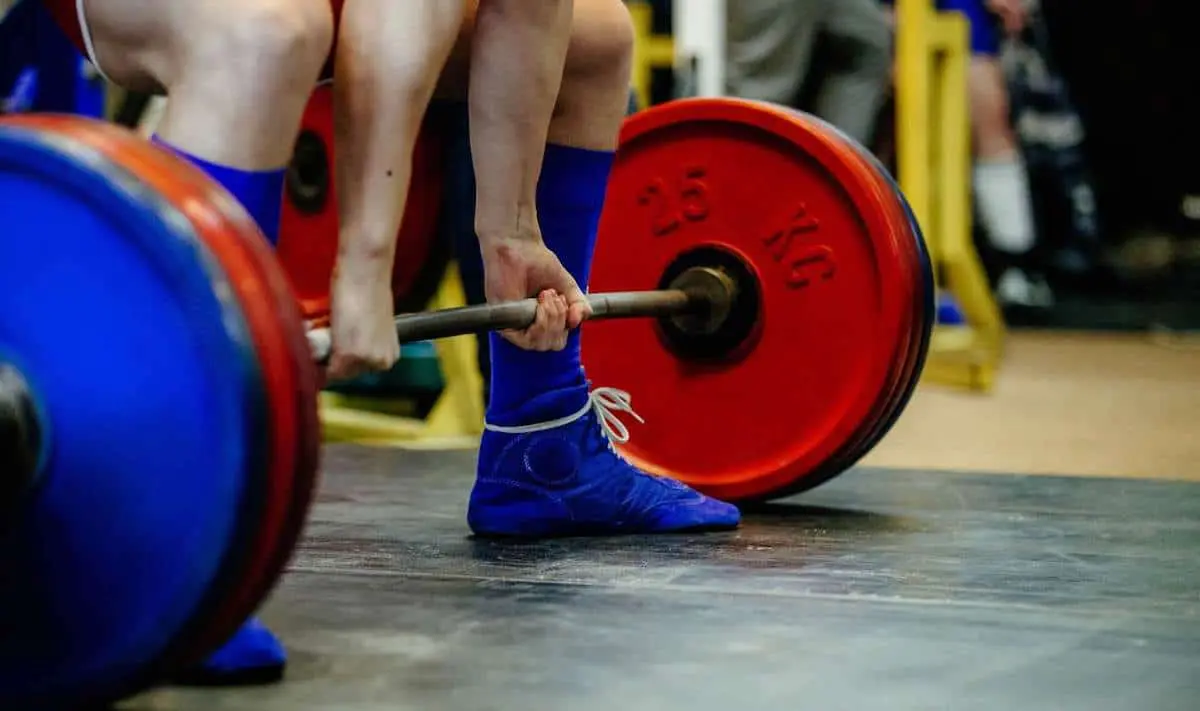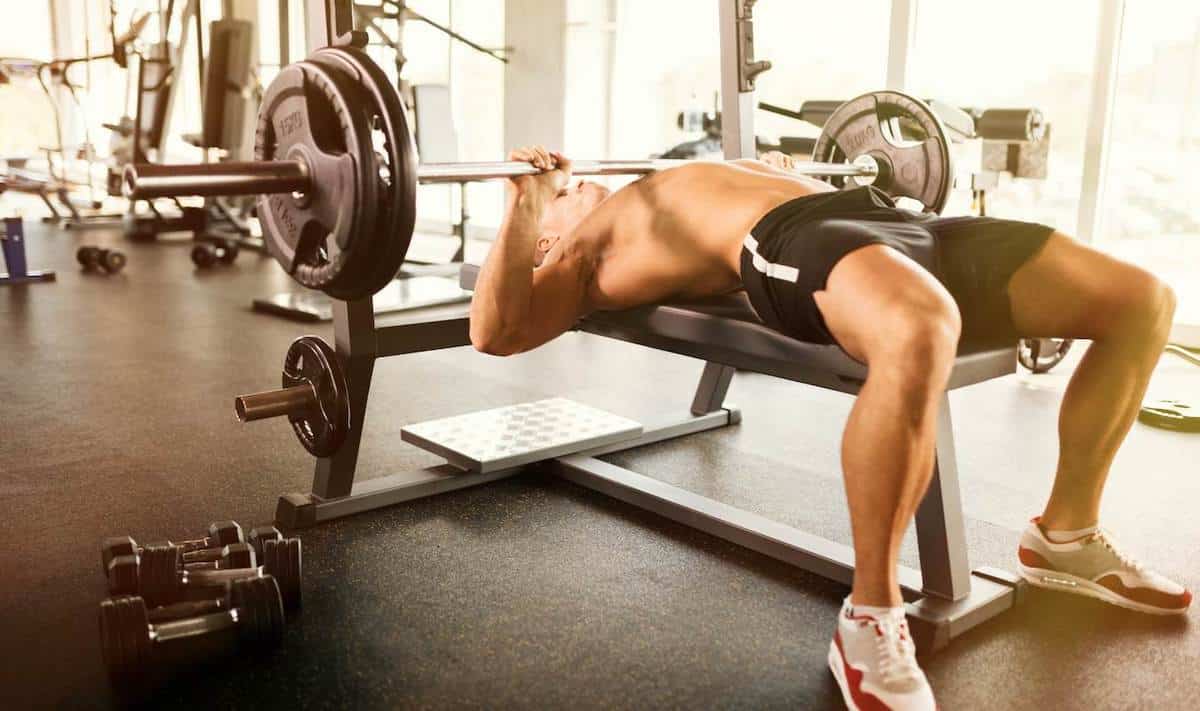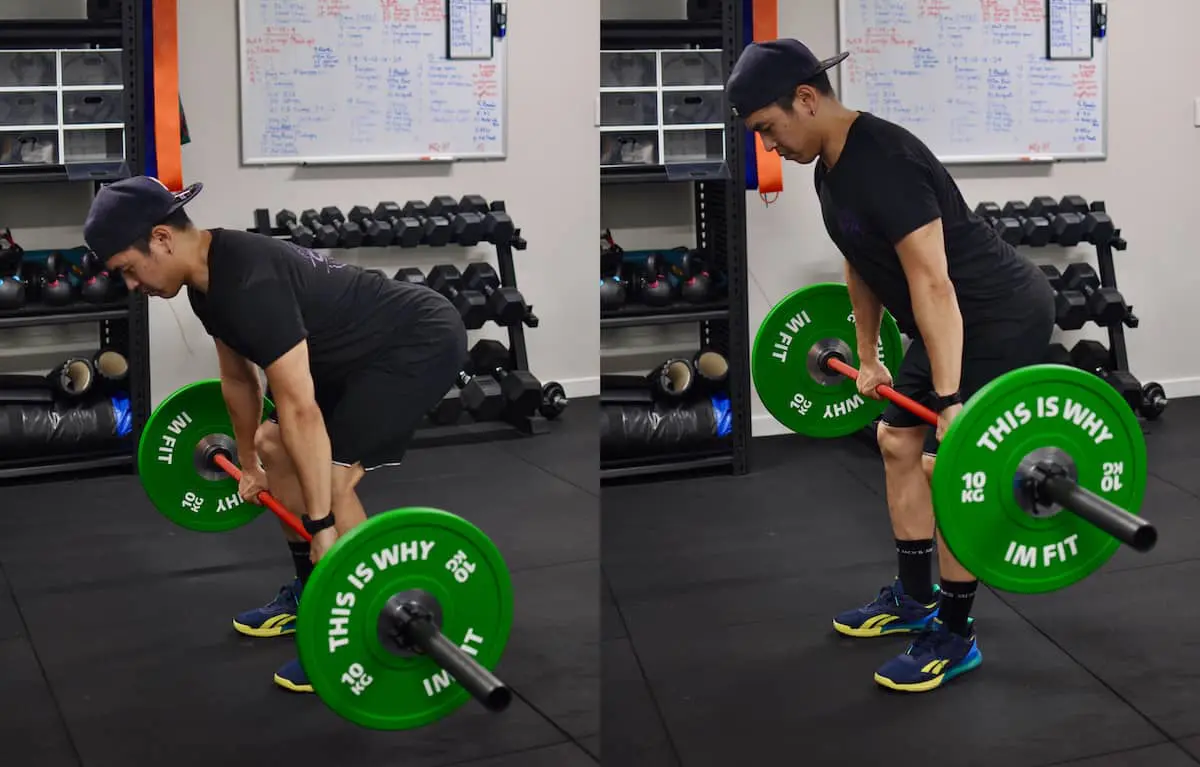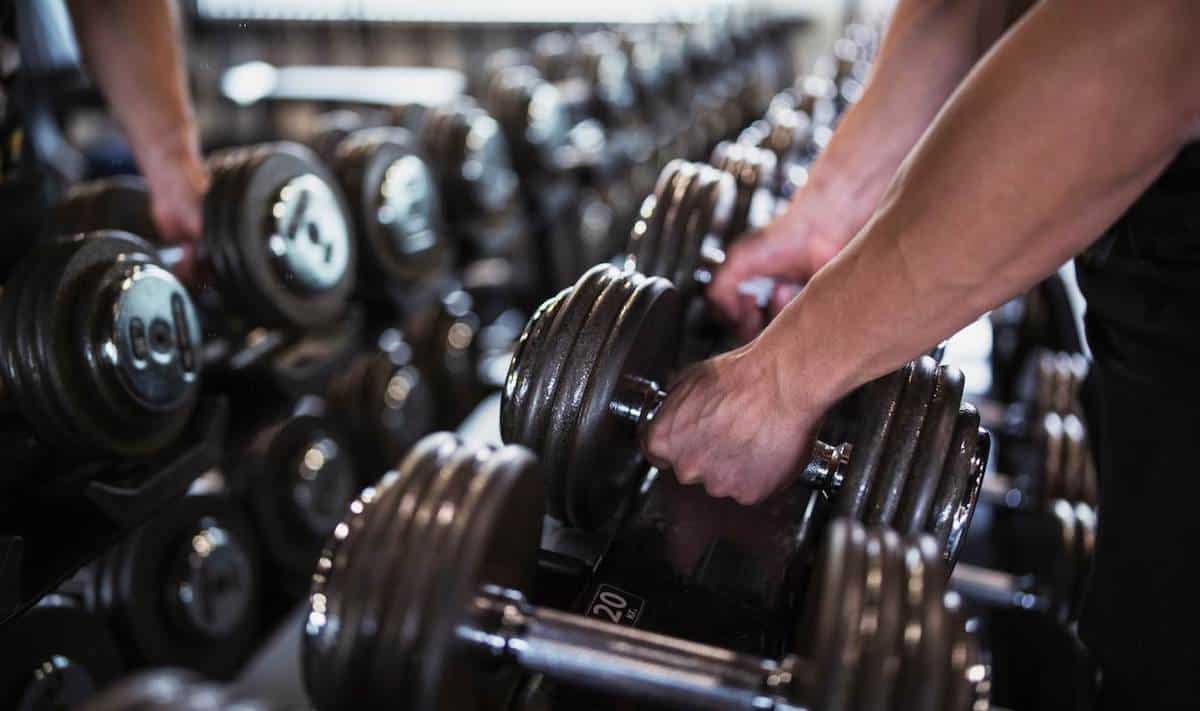
The best online fitness resource you'll ever need. We filter out the BS to ensure you meet your health and fitness goals!

The best online fitness resource you'll ever need. We filter out the BS to ensure you meet your health and fitness goals!

Here’s our 12 Week Powerlifting Program designed specifically to improve your Big Three lifts (bench, deadlift, and squat) , raise your total, and help you through the traditional sticking points for future success.
Jump to the program now!
Alternatively, you can download the free PDF version of the program using the link below:
| Program style | Powerlifting training |
| Workout duration | 1-2 hours |
| Scheduling | 4 days a week |
| Goal | Build muscle |
| Level | Beginners to advanced |
| Target Gender | Male and Female |
This program is structured for the lifter who’s familiar with the powerlifts and wants to prepare for a competition using a 12-week peaking cycle.
Even if you’re not actually training for a competition, following this program will take you through a cycle similar to what might be followed for one. When you’re finished with the 12-week program, take a week or two off, then repeat with heavier weights.
By contrast, it is not an off-season program for building supportive strength and explosive power that in turn can improve the Big Three powerlifts.

You can expect for your powerlifting total to go up and your basis strength for each lift to increase. How much will each individual lift improve? No one can guarantee that. Results will vary.
You can also expect to gain additional mastery of the lifts. I’ve included isolation work designed to help you with those frustrating sticking points.
Auxiliary work is tossed in to get your supporting cast of muscles work they need. Do those right and you can also expect some physique benefits as well. Keep in mind it’s not a bodybuilding program so any aesthetic improvement will be incidental.
The program follows an established old-school progressive resistance format that utilizes increased tonnage as reps and sets decrease over the course of the 12 weeks.
| Day | Split |
|---|---|
| 1 | Deadlift Day / Auxiliary Squat |
| 2 | Bench Day |
| 3 | Rest |
| 4 | Squat Day / Auxiliary Deadlift |
| 5 | Auxiliary Lift Day |
| 6 | Rest |
| 7 | Rest |
Day 1 is Deadlift Day with auxiliary squatting included. I’ve included exercises that worked very well for me and for my teammates, all of whom were elite lifters. These are really “old school”, so you may not have heard of these awesome variations before. But get ready, because they will get you stronger if you do them correctly and don’t let your ego get in front of your muscles.

The Halting Deadlift helps break through the mid-range sticking point where the bar passes the knees. “Halting” gets its name from it being a partial deadlift “halted” before you finish locking out the deadlift.
You lift the weight to just beyond your knees then rep from shins to mid-thigh without ever setting the weight down or locking out.
For me, “halting” deadlifts were responsible for a lot of gains.
Because there’s no lock-out and no setting down of the weight, you’re forced to keep the weight moving without rest for the entire set. They are extremely challenging especially because they must be done with perfect form to avoid injury.
Until the last week of the program, this program calls for your repping your deadlift sets. During the last week, you’ll switch to sets of consecutive singles.
What do I mean by this? Don’t all sets contain reps? Yes, and no.
A repped set of deadlifts means the bar is picked up and never brought to rest on the platform, not even for a second. And it’s definitely not bounced off the platform.
The guys I’ve seen do this best known their range of motion so well that they can start their next rep when the bar is millimeters above the platform. The weight never even touches but man, does it get close.
Repping deadlifts in this way keeps the load on the muscles and builds muscular size and strength. It also gets the muscles accustomed to the fatigue of ever-greater weights.
The last week, transition to sets of singles, where you’ll set the weight back down, reload, and repeat in rapid fashion. This trains the muscles to get accustomed to dealing with the clock during a competition when time between attempts is limited and you may be needing to follow yourself.
Sets of singles also practice confident set-up for competition singles. You need to get good at approaching the bar, setting up the same way each time, and doing so efficiently without a lot of fanfare.
Tuesday was bench day. For this program, you can substitute a good chest press machine instead.
The same training principles apply, and if you’re fortunate enough to train in a gym with an excellently designed chest press machine (e.g. converging handles and good back support), you can also expect to develop some nice pecs and anterior delts in the process.
We always tossed in some hammer curls and triceps pushdowns on bench day. They make sense to train on chest day.
We did not do shoulder presses. I’ve added them to round out the strength routine.
For anyone who was training for a powerlifting competition though, I wouldn’t include shoulder presses. It’s too much work and would be difficult to recover from week-to-week prior to competition date.
Day Three is a rest day. Don’t go into the gym. Rest up and get ready for Squat Day.
The dreaded Squat Day.
When the weights get big, Squat Day can get pretty intimidating. There’s nothing like stepping out of the rack with a quarter ton on your back with the bar bending.
Squat Day features add-on squat variations–Bottom End Drives, Paused Reps–that can get you stronger in those spots where it’s easy to get stuck: the bottom, the lock-out, and that transitional phase when the hip extensors take over from the lift from the knee extensors.
Bottom End Drives are to the Squat what Haltings are to Deadlifts. No relief.
Where Halting Deadlifts (mentioned earlier) work the mid-range sticking point, Rack Pulls add strength for a powerful, secure lock–out.
Set the rack pins a short distance (12cm/3” or so) below your usual sticking point.
Pull the weight off the pins and perform the specified number of reps without resting the bar back on the pins. Just “kiss” the pins with the bar when finishing one rep and starting another. The goal is to keep the tension on the bar without release for the entire set.
Use straps for Rack Pulls.
Auxiliary Day is for the lighter support muscle work, with higher reps and lighter weights.
When I followed this routing, I loved auxiliary days (partly because they fell on Fridays and, well, Fridays are pretty awesome anyway.)
Days 6 and 7 are rest days. Recover from the week’s hard work and get your mind right for the next week’s lifts, because everything’s going to be heavier…at least on paper.
| Exercise | Set 1 | Set 2 | Set 3 | Set 4 |
|---|---|---|---|---|
| Deadlift warm up (bar only) | 30 | 20 | 15 | 10 |
| Deadlifts | 6-8 | 6-8 | 6-8 | 6-8 |
| “Halting” RDLs (no lock out, no ground touch between reps) | 8-10 | 8-10 | ||
| Leg Press | 10-12 | 10-12 | ||
| DB or Hex Bar VMO Squats (Heel elevated) | 10-12 | 10-12 | ||
| Shrugs | 10-12 | 10-12 |
| Exercise | Set 1 | Set 2 | Set 3 | Set 4 |
|---|---|---|---|---|
| Bench press warm up (bar only) | 30 | 20 | 15 | 10 |
| Bench Press | 6-8 | 6-8 | 6-8 | 6-8 |
| Bench Press with 2-second Pause | 8-10 | 8-10 | ||
| Hammer Curls | 10-12 | 10-12 | ||
| Triceps extensions (Cable, DB, or EZ Curl) | 10-12 | 10-12 |
| Exercise | Set 1 | Set 2 | Set 3 | Set 4 |
|---|---|---|---|---|
| Squat warm up (bar only) | 30 | 20 | 15 | 10 |
| Squats | 6-8 | 6-8 | 6-8 | 6-8 |
| Bottom-end Drives | 8-10 | 8-10 | ||
| Squats with Pause at Bottom | 8-10 | 8-10 | ||
| Rack pulls | 10-12 | 10-12 | 10-12 | 10-12 |
| Leg Curls | 15-20 | 12-15 |
| Exercise | Set 1 | Set 2 | Set 3 |
|---|---|---|---|
| DB Flat Bench | 15-20 | 12-15 | 12-15 |
| Palms-Up Front Raises (DB or Cable) | 15-20 | 12-15 | 12-15 |
| Lat Pull-Downs or Pull-ups | 15-20 | 12-15 | 12-15 |
| Hammer Curls | 15-20 | 12-15 | 12-15 |
| Triceps extensions (Cable, DB, or EZ Curl) | 15-20 | 12-15 | 12-15 |
| Exercise | Set 1 | Set 2 | Set 3 | Set 4 |
|---|---|---|---|---|
| Deadlift warm up (bar only) | 20 | 15 | 10 | 8 |
| Deadlifts | 5 | 5 | 5 | 5 |
| “Halting” RDLs (no lock out, no ground touch between reps) | 8-10 | 8-10 | ||
| Leg Press | 8-10 | 8-10 | ||
| DB or Hex Bar VMO Squats (Heel elevated) | 8-10 | 8-10 | ||
| Shrugs | 8-10 | 8-10 |
| Exercise | Set 1 | Set 2 | Set 3 | Set 4 |
|---|---|---|---|---|
| Bench press warm up (bar only) | 20 | 15 | 10 | 8 |
| Bench Press | 5 | 5 | 5 | 5 |
| Bench Press with 2-second Pause | 8-10 | 8-10 | ||
| Hammer Curls | 10-12 | 10-12 | ||
| Triceps extensions (Cable, DB, or EZ Curl) | 10-12 | 10-12 |
| Exercise | Set 1 | Set 2 | Set 3 | Set 4 |
|---|---|---|---|---|
| Squat warm up (bar only) | 20 | 15 | 10 | 8 |
| Squats | 5 | 5 | 5 | 5 |
| Bottom-end Drives | 8-10 | 8-10 | ||
| Squats with Pause at Bottom | 8-10 | 8-10 | ||
| Rack pulls | 8-10 | 8-10 | 8-10 | 8-10 |
| Leg Curls | 12-15 | 10-12 |
| Exercise | Set 1 | Set 2 | Set 3 |
|---|---|---|---|
| DB Flat Bench | 12-15 | 10-12 | 10-12 |
| Palms-Up Front Raises (DB or Cable) | 12-15 | 10-12 | 10-12 |
| Lat Pull-Downs or Pull-ups | 12-15 | 10-12 | 10-12 |
| Hammer Curls | 12-15 | 10-12 | 10-12 |
| Triceps extensions (Cable, DB, or EZ Curl) | 12-15 | 10-12 | 10-12 |
| Exercise | Set 1 | Set 2 | Set 3 | Set 4 |
|---|---|---|---|---|
| Deadlift warm up (bar only) | 15 | 10 | 8 | 5 |
| Deadlifts | 3 | 3 | 2 | 2 |
| “Halting” RDLs (no lock out, no ground touch between reps) | 6-8 | 6-8 | ||
| Leg Press | 6-8 | 6-8 | ||
| DB or Hex Bar VMO Squats (Heel elevated) | 6-8 | 6-8 | ||
| Shrugs | 6-8 | 6-8 |
| Exercise | Set 1 | Set 2 | Set 3 | Set 4 |
|---|---|---|---|---|
| Bench press warm up (bar only) | 15 | 10 | 8 | 5 |
| Bench Press | 3 | 3 | 2 | 2 |
| Bench Press with 2-second Pause | 6-8 | 6-8 | ||
| Hammer Curls | 10-12 | 10-12 | ||
| Triceps extensions (Cable, DB, or EZ Curl) | 10-12 | 10-12 |
| Exercise | Set 1 | Set 2 | Set 3 | Set 4 |
|---|---|---|---|---|
| Squat warm up (bar only) | 15 | 10 | 8 | 5 |
| Squats | 3 | 3 | 2 | 2 |
| Bottom-end Drives | 6-8 | 6-8 | ||
| Squats with Pause at Bottom | 6-8 | 6-8 | ||
| Rack pulls | 6-8 | 6-8 | ||
| Leg Curls | 10-12 | 8-10 |
| Exercise | Set 1 | Set 2 | Set 3 |
|---|---|---|---|
| DB Flat Bench | 10-12 | 8-10 | 20 |
| Palms-Up Front Raises (DB or Cable) | 10-12 | 8-10 | 20 |
| Lat Pull-Downs or Pull-ups | 10-12 | 8-10 | |
| Hammer Curls | 10-12 | 8-10 | |
| Triceps extensions (Cable, DB, or EZ Curl) | 10-12 | 8-10 |

In-season competition powerlifting routines are designed for the load on the bar to increase each week. How much you decide to raise the weight each week is up to you. But as you progress, it’s the weight that should increase and not the number of reps or sets. Increasing sets and reps can happen in off-season routines.
Decide what your max should be at the end of the routine. I had most success by training for a double. And the target double should be your opening weight at the competition, and not your target personal best.
Nailing the target double in the gym shortly before the competition assured me that I’d stay in the meet, and not bomb out like a novice. The second attempt would be the weight I had in mind for PB, then the third would be my “go for it” weight.
Here’s what you need to do before you start the routine:
As far as diet is concerned, this is *not* the time to worry about your abs. You need to decide your competition weight, your target lifts, and eat accordingly.
This doesn’t mean you need to bulk either. If you’re going to lift as a 181 (82.5kg), and you’re weighing 180 when you start, then you’re going to need to do some serious meal planning and avoid the cheats.
Now, if you’re moving from the 165 (75kg) class to 181, then stock the fridge and chow down. Get sufficient calories and protein and enjoy the ride. Just don’t overdo it and end up lifting with the beasts in the 198 class.
If you’re following this routine to reach a new PB, then making a particular weight is less important and you can relax a little. Worry about your abs if you like.
One thing is for sure: to grow your powerlifts, you cannot be in a crazy calorie deficit where your energy is low during your workouts. You need to be getting sufficient carbs especially for energy. Protein is a terrible source of energy.

Powerlifting ain’t easy – you’ll be training hard. Which means you’ll need those rest days. Yes… 3 rest days per week isn’t extreme.
Clinical evidence supports two rest days, with the inside range being 1 day and the outside being as many as 3 days between workouts.
But it depends.
Factors such as the type of exercise performed, the intensity and duration of the workout, and your level of fitness.
Studies of interest that investigated muscle recovery time:
Overall, it appears that a recovery period of at least 48 hours is necessary for maximal muscle recovery after resistance training, although the exact recovery time can vary depending on individual factors and the specific type of exercise performed
If you feel completely recovered from an Upper or Lower day mid-week, there’s no unbreakable rule that says you can’t do an additional Upper or Lower day during the same calendar week.
You just need to be really honest with yourself, and dialed in to what your body tells you.
Now, if you really want to get sophisticated about this stuff like a pro, think about the fatigue on your central nervous system (CNS).
That means your brain, spinal cord, and all the electro-chemical activity that goes on during and after an intense workout. A challenging shoulder day can absolutely impact your next leg day if the CNS is fatigued.

Rest a minute or two between warm-up sets. Your “working” sets will require longer rest times.
Target three minutes between sets. Spend that time analyzing the set you just did. Ask:
Then, visualize your next set.
Please. Please. Please. Please…do NOT use your time between sets to whip out your smartphone, check your social media, or snap a photo of your beastly physique.
Download our 12 Week Powerlifting Training Program PDF here:
What exactly are bottom end drives ? On squat day
Apologies for the tardy reply Jason! Bottom End Drives are a set of squats where we try to keep full tension in the legs. Once the femurs pass above parallel, the lifter descends again. All reps are essentially “in the bottom”.
The “bottom” is the lower half of the squat. A bottom end drive gets nowhere near lockout. Think of the parallel position in a squat where the line between the hip joint and knee is parallel to the floor. The bottom end drive is performed on about 5” either side of that line. All the way down and then just above parallel.
Few can or will do them… the discipline is in not getting anywhere near lockout and working a methodical slow controlled rep in that range. Hope that helps!